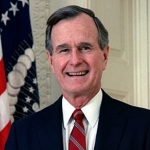Background
Ronald Wilson Reagan was born on February 6, 1911, in Tampico, Illinois. He was the second son of John Edward ("Jack") and Nelle Wilson Reagan.

1920
Dixon, Illinois, USA
As a teenager, in Dixon, Illinois.
1941
The Bad Man (1941)
1942
Reagan and his first wife Jane Wyman, 1942.
1952
Wedding of Ronald and Nancy Reagan, 1952. Matron of honor Brenda Marshall (left) and best man William Holden (right) were the sole guests.
1952
American actor Ronald Reagan and his wife Nancy Reagan gaze at one another across a table, circa 1952.
1953
Ronald Reagan (191102004), US actor, in costume and on horseback in a publicity still issued for the film, 'Law and Order', 1953. The Western, directed by Nathan Juran (1907-2002), starred Reagan as 'Frame Johnson'.
1955
Family portrait of American actor Ronald Reagan wearing a polka-dot scarf and two-tone shoes with his wife American actor Nancy Davis, their daughter Patti Davis and their infant son Ron Jr.
1956
American actor Ronald Reagan and his wife Nancy Reagan sit at a restaurant table, looking at a brochure at the premiere party for the film, 'Moby Dick,' directed by John Huston, 1956.
1964
Nancy and Ronald Reagan aboard a boat in California, 1964
1965
American actor and politician Ronald Reagan in a scene from the 'Temporary Warden' episode of the 'Death Valley Days' television series, September 30, 1965.
1968
American politician and Governor of California (and future US President) Ronald Reagan (1911 - 2004) reads on an airplane during a campaign trip through the midwest and southern states, April 1968.
1970
The Reagans meet with President Richard Nixon and First Lady Pat Nixon, July 1970.
1970
The Reagans meet with President Richard Nixon and First Lady Pat Nixon, July 1970.
1972
California governor Ronald Reagan speaks during an interview, circa 1972.
1976
Reagan and President Gerald Ford shake hands on the podium after Reagan narrowly lost the nomination at the 1976 Republican National Convention.
1976
At his home at Rancho del Cielo
1980
40th president of the United States of America and a former film and television actor Ronald Reagan during a TV debate with Jimmy Carter just before the Presidential elections.
1980
Former California Governor and future 40th President of the United States, Ronald Wilson Reagan poses in his Los Angeles, California, offices during the 1980 presidential campaign.
1980
Badge for the 1980 ial Election, featuring Ronald Reagan (1911-2004) and George Bush, with the words 'Reagan-Bush in '80, Let's Make America Great Again.' USA, 1980.
1980
Los Angeles, California, USA
President Ronald Reagan poses for a portrait in 1980 in Los Angeles, California.
1981
Inauguration parade (January 20, 1981). As Reagan read his inauguration address, 52 U.S. hostages (held by Iran for 444 days) were set free.
1981
Reagan outlines his plan for Tax Reduction Legislation in a televised address from the Oval Office, July 1981.
1981
Reagan addresses Congress on the Program for Economic Recovery, April 28, 1981 (a few weeks after surviving an assassination attempt).
1981
Washington, DC., USA
President Ronald Reagan and wife Nancy wave to the crowd from the Presidential Limousine as they ride down Pennsylvania Avenue during the Inaugural parade on January 20, 1981, in Washington, DC.
1982
As the first U.S. president invited to speak before the British Parliament (June 8, 1982), Reagan predicted Marxism would end up on the "ash heap of history."
1982
Reagan in 1982
1982
Queen Elizabeth II riding in the grounds of Windsor Castle with US President Ronald Reagan, during his state visit to the UK, 8th June 1982. She is riding her horse 'Burmese' and he is mounted on 'Centennial,' both gifts to the Queen from the Canadian Mounted Police.
1983
1600 Pennsylvania Ave NW, Washington, DC 20502, USA
Meeting with leaders of the Afghan Mujahideen in the Oval Office, 1983.
1983
Reagan (far left) and First Lady Nancy Reagan pay their respects to the 17 American victims of the April 18 attack on the U.S. embassy by Hezbollah in Beirut, 1983.
1984
US President Ronald Reagan sits with British Prime Minister Margaret Thatcher at 10 Downing Street, London on June 05, 1984.
1985
Reagan with actress Sigourney Weaver and King Fahd of Saudi Arabia in 1985. The U.S. and Saudi Arabia supplied money and arms to the anti-Soviet fighters in Afghanistan.
1985
President Reagan and Soviet General Secretary Gorbachev, 1985.
1986
British Prime Minister Margaret Thatcher (here with Reagan in 1986) granted the U.S. use of British airbases to launch the Libya attack.
1987
President Reagan with real estate developer and future president Donald Trump in 1987.
1987
Challenging Gorbachev to "tear down this wall!" at the Brandenburg Gate, June 12, 1987.
1987
1600 Pennsylvania Ave NW, Washington, DC 20502, USA
Gorbachev and Reagan sign the INF Treaty at the White House, December 1987.
1987
1600 Pennsylvania Ave NW, Washington, DC 20502, USA
Portrait of U.S. President Ronald Reagan (R) posing with Soviet president Mikhail Gorbachev in the White House library, Washington, D.C., December 8, 1987.
1988
Moscow, Russia
In this handout from the White House, U.S. President Ronald Reagan (2nd R) shakes hands with a boy as Mikhail Gorbachev (R) looks on during a tour of Red Square May 31, 1988 in Moscow, Soviet Union.
1989
Los Angeles, CA, USA
ormer U.S. President Ronald Reagan does an interview with Hugh Sidney of Time Magazine in 1989.
1990
Florida, USA
Serena Williams and her sister Venus Williams stand with former President Ronald Reagan at a tennis camp in Florida.
1990
San Francisco, USA
President of the Soviet Union Mikhail Gorbachev and U.S. President Ronald Reagan during an informal meeting in San Francisco, USA, 4th June 1990.
1992
1600 Pennsylvania Ave NW, Washington, DC 20502, USA
The Reagans in Los Angeles after leaving the White House, 1992
1993
Former President Reagan returns to the White House to receive the Presidential Medal of Freedom from President Bush, 1993.
1996
The Reagans with a model of USS Ronald Reagan, May 1996. At left is Newport News Shipbuilding Chairman and CEO Bill Fricks.
2004
ormer U.S. President Ronald Reagan and First Lady Nancy Reagan share a moment in this undated file photo. Reagan turns 93 on February 6, 2004.
A bronze statue of Reagan standing in the Capitol rotunda (a part of the National Statuary Hall Collection)
555 College Way, Dixon, CA 95620, USA
Ronald Reagan studied at Dixon High School.
Ronald Reagan studied at Eureka College.
Dixon, Illinois, USA
Ronald Reagan's boyhood home in Dixon, Illinois
Wedding of Ronald and Nancy Reagan, 1952. Matron of honor Brenda Marshall and best man William Holden were the sole guests
Ronald Reagan's Mother Nelle and Father Jack Reagan
Official Portrait of President Ronald Reagan.
Capt. Ronald Reagan at Fort Roach.
Guest stars for the premiere of The Dick Powell Show. Reagan can be seen wearing a ten-gallon hat on the far left.
506 S Grand Ave, Los Angeles, CA 90071, USA
Ronald and Nancy Reagan wave to the crowd during his gubernatorial victory celebration at the Biltmore Hotel, Los Angeles.
First St SE, Washington, DC 20004, USA
Reagan is sworn in for a second term as president by Chief Justice Burger in the Capitol rotunda.
Reagan (center) receives the Tower Commission Report regarding the Iran-Contra affair in the Cabinet Room with John Tower (left) and Edmund Muskie (right).
Reagan lying in state in the Capitol rotunda,
A bronze statue of Reagan standing in the Capitol rotunda (a part of the National Statuary Hall Collection).
c. 1916–17. Pictured from left: Father Jack, older brother Neil, Reagan (with "Dutchboy" haircut), and mother Nelle.
American actor and politician Ronald Reagan poses in front of a rough brick wall for a portrait, circa the 1960s.
Ronald Reagan
Ronald Reagan
Ronald Reagan
Pres. Ronald Reagan (L) laughing at quip by Queen Elizabeth re weather during state dinner.
Soviet Pres. Mikhail Gorbachev (L) & Pres. Reagan out for a stroll during the summit in Wash., DC.
Pres. Ronald Reagan walking & giving a thumbs-up gesture on S. Lawn after returning from MA.
CA gubernatorial candidate Ronald Reagan holding hands w. wife Nancy while on the campaign trail.
Ronald Reagan
Ronald Reagan
Ronald Reagan
President Ronald Reagan and wife Nancy holding their pet cats, Cleo, and Sara outside on their ranch.
Actor & CA gubernatorial candidate Ronald Reagan sitting with wife Nancy & son Ronnie at home in the living room.
Ronald Wilson Reagan
Ronald Wilson Reagan
Ronald Wilson Reagan
Ronald Wilson Reagan
Ronald Wilson Reagan
President Ronald Reagan
President Ronald Reagan
President Ronald Reagan
While addressing the audience at the White House News Photographers Association dinner, President Reagan said, "I've been told this is all off the record and the cameras are off and I've been waiting years to do this."
President Reagan laughs following a joke by the straight-faced Queen Elizabeth II, who commented on the lousy California weather she has experienced since her arrival to the States. The British Queen is delivering a brief address during a state dinner held at the De Young Museum in San Francisco.
Ronald Reagan, making his famous challenge to Mikhail Gorbachev to tear down the Berlin Wall.
Washington, DC, USA
President-elect Ronald Reagan takes the oath of office during inauguration ceremonies in Washington, DC. His wife, Nancy, is holding the Bible and Chief Justice Warren Burger is administering the oath.
Ronald Reagan
President Ronald Reagan and Soviet General Secretary Mikhail Gorbachev signing the arms control agreement banning the use of intermediate-range nuclear missiles, the Intermediate Nuclear Forces Reduction Treaty.
President Ronald Reagan showing support for the Strategic Defense Initiative, nicknamed Star Wars. The bumper sticker reads SDI could ruin a nuclear bomb's whole day.
After a meeting in New York, President Ronald Reagan, Vice President George Herbert Walker Bush and Soviet General Secretary Mikhail Gorbachev pose with the World Trade Center in the background.
President Ronald Reagan
President Ronald Reagan
President Ronald Reagan
President Ronald Reagan makes a stump speech in front of a large American flag.
President Ronald Reagan





































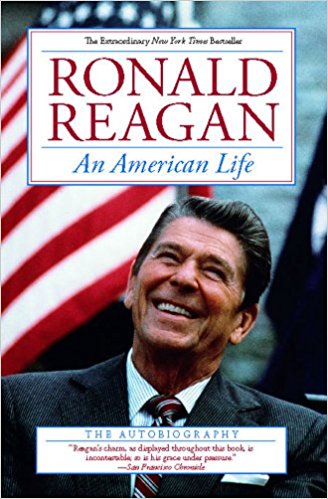
(Few presidents have accomplished more, or been so effecti...)
Few presidents have accomplished more, or been so effective in changing the direction of government in ways that are both fundamental and lasting, than Ronald Reagan. Certainly, no president has more dramatically raised the American spirit or done so much to restore national strength and self-confidence. This indispensable Reagan retrospective is perfect for fathers, graduates, and anyone looking to find inspiration in the thoughts and musings of a great American leader.
http://www.amazon.com/gp/product/1451628390/?tag=2022091-20
1990
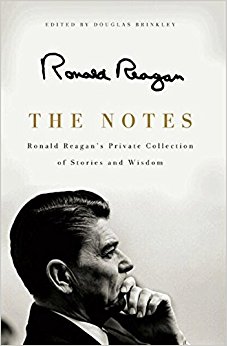
(Ronald Reagan left behind a legacy that America will neve...)
Ronald Reagan left behind a legacy that America will never forget. Now, in this one-of-a-kind collection of his most intimate thoughts, his favorite quotations by others, and his own most collectible jokes, all culled from a newly disclosed set of personal notecards he kept throughout his life and career, fans and admirers of the fortieth president will find a unique window of insight into the soul of an American icon.
http://www.amazon.com/gp/product/0062065130/?tag=2022091-20
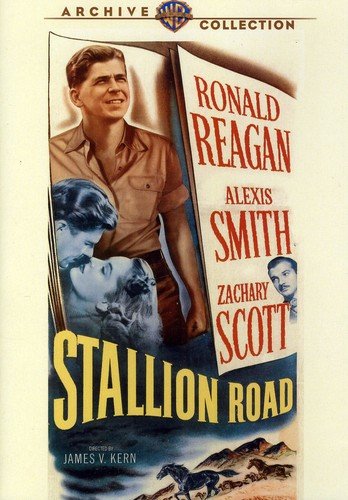
(Outdoorsy California rancher-politician Ronald Reagan see...)
Outdoorsy California rancher-politician Ronald Reagan seems right at home playing outdoorsy California rancher-veterinarian Larry Hanrahan in this action-filled melodrama scripted by Stephen Longstreet from his novel. Always impressive astride a horse, Reagan spends plenty of time in the saddle as Larry contends with the attentions of two beautiful women (Alexis Smith and Peggy Knudsen), the romantic rivalry provided by his writer pal (Zachary Scott), and the terrors of an anthrax outbreak that threatens local livestock and Larry himself when he contracts the dread disease. Among the visual highlights: an exciting horse-jumping contest and magnificent location shooting in the Sierra Madre range.
https://www.amazon.com/-/es/Stallion-Road-Ronald-Reagan/dp/B004MFFB4E/ref=sr_1_1?__mk_es_US=%C3%85M%C3%85%C5%BD%C3%95%C3%91&dchild=1&keywords=Ronald+Reagan+Stallion+Road&qid=1597391843&sr=8-1
1938
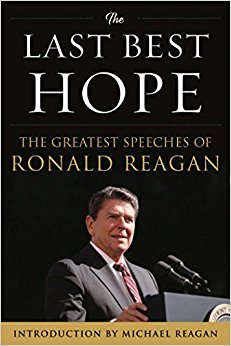
(From the time he arrived on the political scene in 1964 –...)
From the time he arrived on the political scene in 1964 – throughout his presidency and beyond, Ronald Reagan – used his speeches to inspire and reinvigorate America. When he spoke, Reagan, said, he was "preaching a sermon." The American people saw his vision of America and his dreams for the future and they overwhelmingly responded; he was re-elected in 984 by the largest number of electoral votes in the nation’s history.
http://www.amazon.com/gp/product/1630060496/?tag=2022091-20
Actor politician president statesman
Ronald Wilson Reagan was born on February 6, 1911, in Tampico, Illinois. He was the second son of John Edward ("Jack") and Nelle Wilson Reagan.
Reagan attended Dixon High School, where he developed interests in acting, sports, and storytelling. His first job involved lifeguarding at the Rock River in Lowell Park in 1927. Over a six-year period, Reagan reportedly performed 77 rescues as a lifeguard. He attended Eureka College, a Disciples-oriented liberal arts school, where he became a member of the Tau Kappa Epsilon fraternity, a cheerleader, and studied economics and sociology. While involved, the Miller Center of Public Affairs described him as an "indifferent student." He majored in economics and sociology and graduated with a C grade. He developed a reputation as a "jack of all trades," excelling in campus politics, sports, and theater. He was a member of the football team and captain of the swim team. He was elected student body president and led a student revolt against the college president after the president tried to cut back the faculty.
In 1937, while in Southern California to cover the Chicago Cubs’ spring training season, Ronald Reagan did a screen test for the Warner Brothers movie studio. The studio signed him to a contract, and that same year he made his film debut in "Love is on the Air," playing a radio news reporter. Over the next three decades, he appeared in more than 50 movies. Among his best-known roles was that of Notre Dame football star George Gipp in the 1940 biographical film "Knute Rockne All American." In the movie, Reagan’s famous line - which he is still remembered for - was "Win one for the Gipper." Another notable role was in 1942 in "Kings Row," in which Reagan portrayed an accident victim who wakes up to discover his legs have been amputated and cries out, "Where’s the rest of me?" (Reagan used this line as the title of his 1965 autobiography.)
During World War II (1939-1945), Reagan was disqualified from combat duty due to poor eyesight and spent his time in the Army making training films.
From 1947 to 1952, and from 1959 to 1960, he served as president of the Screen Actors Guild (SAG), during which time he testified in front of the House UN-American Activities Committee (HUAC). From 1954 to 1962, he hosted the weekly television drama series "The General Electric Theater." In this role, he toured the United States as a public relations representative for General Electric, giving pro-business talks in which he spoke out against too much government control and wasteful spending, central themes of his future political career.
In his younger years, Ronald Reagan was a member of the Democratic Party and campaigned for Democratic candidates; however, his views grew more conservative over time, and in the early 1960s he officially became a Republican.
In 1964, Reagan stepped into the national political spotlight when he gave a well-received televised speech for Republican presidential candidate Barry Goldwater (1909-1998), a prominent conservative. Two years later, in his first race for public office, Reagan defeated Democratic incumbent Edmund "Pat" Brown Sr. (1905-1996) by almost 1 million votes to win the governorship of California. Reagan was re-elected to a second term in 1970.
After making unsuccessful bids for the Republican presidential nomination in 1968 and 1976, Reagan received his party’s nod in 1980. In that year’s general election, he and running mate George H. W. Bush (1924) faced off against President Jimmy Carter (1924) and Vice President Walter Mondale (1928). Reagan won the election by an electoral margin of 489-49 and captured almost 51 percent of the popular vote. At age 69, he was the oldest person elected to the United States presidency.
Ronald Reagan was sworn into office on January 20, 1981. In his inaugural address, Reagan famously said of America’s then-troubled economy, "In this present crisis, the government is not the solution to our problems; government is the problem."
After the more informal Carter years, Reagan and his wife Nancy ushered in a new era of glamour in the nation’s capital, which became known as Hollywood on the Potomac. The first lady wore designer fashions, hosted numerous state dinners, and oversaw a major redecoration of the White House.
Just over two months after his inauguration, on March 30, 1981, Reagan survived an assassination attempt by John Hinckley Jr. (1955), a man with a history of psychiatric problems, outside a hotel in Washington, D. C. The gunman’s bullet pierced one of the president’s lungs and narrowly missed his heart. Reagan, known for his good-natured humor, later told his wife, "Honey, I forgot to duck." Within several weeks of the shooting, Reagan was back at work.
On the domestic front, President Ronald Reagan implemented policies to reduce the federal government’s reach into the daily lives and pocketbooks of Americans, including tax cuts intended to spur growth (known as Reaganomics). He also advocated for increases in military spending, reductions in certain social programs, and measures to deregulate business.
By 1983, the nation’s economy had started to recover and enter a period of prosperity that would extend through the rest of Reagan’s presidency. Critics maintained that his policies led to budget deficits and a more significant national debt; some also held that his economic programs favored the rich.
In 1981, Reagan made history by appointing Sandra Day O’Connor (1930) as the first woman to the United States Supreme Court.
In foreign affairs, Ronald Reagan’s first term in office was marked by a massive buildup of United States weapons and troops, as well as an escalation of the Cold War (1946-1991) with the Soviet Union, which the president dubbed "the evil empire." Key to his administration’s foreign policy initiatives was the Reagan Doctrine, under which America provided aid to anticommunist movements in Africa, Asia, and Latin America. In 1983, Reagan announced the Strategic Defense Initiative (SDI), a plan to develop space-based weapons to protect America from attacks by Soviet nuclear missiles.
Also on the foreign affairs front, Reagan sent 800 United States Marines to Lebanon as part of an international peacekeeping force after Israel invaded that nation in June 1982. In October 1983, suicide bombers attacked the Marine barracks in Beirut, killing 241 Americans. That same month, Reagan ordered United States forces to lead an invasion of Grenada, an island in the Caribbean, after Marxist rebels overthrew the government. In addition to the problems in Lebanon and Grenada, the Reagan administration had to deal with an ongoing contentious relationship between the United States and Libyan leader Muammar al-Gaddafi (1942).
During his second term, Reagan forged a diplomatic relationship with the reform-minded Mikhail Gorbachev (1931), who became the leader of the Soviet Union in 1985. In 1987, the Americans and Soviets signed a historic agreement to eliminate intermediate-range nuclear missiles. That same year, Reagan spoke at Germany’s Berlin Wall, a symbol of communism, and famously challenged Gorbachev to tear it down. Twenty-nine months later, Gorbachev allowed the people of Berlin to dismantle the wall. After leaving the White House, Reagan returned to Germany in September 1990 - just weeks before Germany was officially reunified–and took several symbolic swings with a hammer at a remaining chunk of the wall.
In November 1984, Ronald Reagan was reelected in a landslide, defeating Walter Mondale and his running mate Geraldine Ferraro (1935), the first female vice-presidential candidate from a major United States political party. Reagan, who announced it was "morning again in America," carried 49 out of 50 states in the election and received 525 out of 538 electoral votes, the largest number ever won by an American presidential candidate.
Reagan died of pneumonia, complicated by Alzheimer's disease, at his home in the Bel Air district of Los Angeles, California, on the afternoon of June 5, 2004. A short time after his death, Nancy Reagan released a statement saying, "My family and I would like the world to know that President Ronald Reagan has died after 10 years of Alzheimer's disease at 93 years of age. We appreciate everyone's prayers." President George W. Bush declared June 11 a National Day of Mourning, and international tributes came in from around the world. Reagan's body was taken to the Kingsley and Gates Funeral Home in Santa Monica, California later in the day, where well-wishers paid tribute by laying flowers and American flags in the grass. On June 7, his body was removed and taken to the Ronald Reagan Presidential Library, where a brief family funeral was held conducted by Pastor Michael Wenning. His body lay in repose in the Library lobby until June 9; over 100,000 people viewed the coffin.
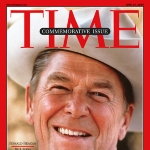
Ronald Reagan is considered one of the most influential presidents in United States history. He received a number of awards in his pre- and post-presidential years.
On Reagan's 87th birthday, in 1998, Washington National Airport was renamed Ronald Reagan Washington National Airport by a bill signed into law by President Bill Clinton. That year, the Ronald Reagan Building and International Trade Center was dedicated in Washington, D.C. He was among 18 included in Gallup's most admired man and woman poll of the 20th century, from a poll conducted in the U.S. in 1999; two years later, USS Ronald Reagan was christened by Nancy Reagan and the United States Navy. It is one of few Navy ships christened in honor of a living person and the first aircraft carrier to be named in honor of a living former president.
After Reagan's death, the United States Postal Service issued a President Ronald Reagan commemorative postage stamp in 2005. Later in the year, CNN, along with the editors of Time magazine, named him the "most fascinating person" of the network's first 25 years; Time listed Reagan one of the 100 Most Important People of the 20th century as well. The Discovery Channel asked its viewers to vote for The Greatest American in June 2005; Reagan placed in the first place, ahead of Lincoln and Martin Luther King Jr.
In 2006, Reagan was inducted into the California Hall of Fame, located at The California Museum.
(Few presidents have accomplished more, or been so effecti...)
1990(Ronald Reagan left behind a legacy that America will neve...)
(Outdoorsy California rancher-politician Ronald Reagan see...)
1938(From the time he arrived on the political scene in 1964 –...)
Reagan's father was Catholic, but Reagan was raised in his mother's Disciples of Christ denomination and was baptized there on September 21, 1922.
Reagan began as a Hollywood Democrat, and Franklin D. Roosevelt was "a true hero" to him. He moved to the right in the 1950s, became a Republican in 1962, and emerged as a leading conservative spokesman in the Goldwater campaign of 1964.
In his early political career, he joined numerous political committees with a left-wing orientation, such as the American Veterans Committee. He fought against Republican-sponsored right-to-work legislation and supported Helen Gahagan Douglas in 1950 when she was defeated for the Senate by Richard Nixon. It was his realization that Communists were a powerful backstage influence in those groups that led him to rally his friends against them.
Reagan spoke frequently at rallies with a strong ideological dimension; in December 1945, he was stopped from leading an anti-nuclear rally in Hollywood by pressure from the Warner Bros. studio. He would later make nuclear weapons a key point of his presidency, specifically his opposition to mutual assured destruction, and he built on previous efforts to limit the spread of nuclear weapons. In the 1948 presidential election, Reagan strongly supported Harry S. Truman, appearing on stage with him during a campaign speech in Los Angeles. However, in the early 1950s, as his relationship with actress Nancy Davis grew, he shifted to the right and endorsed the presidential candidacies of Dwight D. Eisenhower in 1952 and 1956 as well as Richard Nixon in 1960.
He was hired by General Electric (GE) in 1954 to host the General Electric Theater, a weekly TV drama series. He also traveled across the country to give talks to over 200,000 GE employees as a motivational speaker. His many speeches - which he wrote himself - were non-partisan but carried a conservative, pro-business message; he was influenced by Lemuel Boulware, a senior GE executive. Boulware, known for his tough stance against unions and his innovative strategies to win over workers, championed the core tenets of modern American conservatism: free markets, anticommunism, lower taxes, and limited government. Eager for a larger stage, but not allowed to enter politics by GE, he quit and formally registered as a Republican. He often said, "I didn't leave the Democratic Party. The party left me."
When the legislation that would become Medicare was introduced in 1961, he created a recording for the American Medical Association (AMA) warning that such legislation would mean the end of freedom in America. Reagan said that if his listeners did not write letters to prevent it, "we will awake to find that we have socialism. And if you don't do this, and if I don't do it, one of these days, you and I are going to spend our sunset years telling our children, and our children's children, what it once was like in America when men were free." He also joined the National Rifle Association (NRA) and would become a lifetime member.
In 1976, Reagan challenged incumbent President Gerald Ford in a bid to become the Republican Party's candidate for president. Reagan soon established himself as the conservative candidate with the support of like-minded organizations such as the American Conservative Union, which became key components of his political base, while President Ford was considered a more moderate Republican.
Reagan's campaign relied on a strategy crafted by campaign manager John Sears of winning a few primaries early to damage the inevitability of Ford's likely nomination. Reagan won North Carolina, Texas, and California, but the strategy failed, as he ended up losing New Hampshire, Florida, and his native Illinois. The Texas campaign lent renewed hope to Reagan, when he swept all 96 delegates chosen in the May 1 primary, with four more awaiting at the state convention. Much of the credit for that victory came from the work of three co-chairmen, including Ernest Angelo, the mayor of Midland, and Ray Barnhart of Houston, whom Reagan as President would appoint in 1981 as director of the Federal Highway Administration.
However, as the GOP convention neared, Ford appeared close to victory. Acknowledging his party's moderate wing, Reagan chose moderate Senator Richard Schweiker of Pennsylvania as his running mate if nominated. Nonetheless, Ford prevailed with 1,187 delegates to Reagan's 1,070. Ford would go on to lose the 1976 presidential election to the Democratic candidate, Jimmy Carter.
Reagan's concession speech emphasized the dangers of nuclear war and the threat posed by the Soviet Union. Though he lost the nomination, he received 307 write-in votes in New Hampshire, 388 votes as an Independent on Wyoming's ballot, and a single electoral vote from a faithless elector in the November election from the state of Washington, which Ford had won over Democratic challenger Jimmy Carter.
After the campaign, Reagan remained in the public debate with the Ronald Reagan Radio Commentary series and his political action committee, Citizens for the Republic, which was later revived in Alexandria, Virginia, in 2009 by the Reagan biographer Craig Shirley.
The 1980 presidential campaign between Reagan and incumbent President Jimmy Carter was conducted amid a multitude of domestic concerns and the ongoing Iran hostage crisis. Reagan's campaign stressed some of his fundamental principles: lower taxes to stimulate the economy, less government interference in people's lives, states' rights, and a strong national defense.
Reagan launched his campaign by declaring "I believe in states' rights." After receiving the Republican nomination, Reagan selected one of his primary opponents, George H. W. Bush, to be his running mate. His appearance in an October televised debate boosted his popularity. Reagan won the election, carrying 44 states with 489 electoral votes to 49 electoral votes for Carter (representing six states and Washington, D.C.). Reagan received 51% of the popular vote while Carter took 41%, and Independent John B. Anderson (a liberal Republican) received 7%. Republicans captured the Senate for the first time since 1952, and gained 34 House seats, but the Democrats retained a majority.
Reagan's self-confidence came from his belief that all men are equal, his belief in his own message, and from his positive outlook on the world.
Quotations:
"When you can't make them see the light, make them feel the heat."
"Life is one grand, sweet song, so start the music."
"Trust, but verify."
"There are no easy answers, but there are simple answers. We must have the courage to do what we know is morally right."
Reagan joined the National Rifle Association (NRA) and would become a lifetime member. He received a lifetime gold membership in the Screen Actors Guild.
The only professional actor to become president, Reagan earned the nickname the Great Communicator for his effective use of television in presenting the administration’s program. He was a gifted raconteur with a seemingly endless store of anecdotes of his days in Hollywood. By all accounts, he was affable, cheerful, even-tempered, and forever optimistic. According to Hedrick Smith of the New York Times, "His aw-shucks manner and charming good looks disarm those who from a distance have thought of him as a far-right fanatic."
Anne Edwards, a chronicler of Reagan’s early years, described him as aloof, intensely private, and reluctant to reveal much about himself to those outside his family. In a rash of so-called kiss-and-tell books by such administration insiders as Budget director David Stockman, press secretary Larry Speakes, White House chief of staff Donald Regan, deputy chief of staff Michael Deaver, and Secretary of State Alexander Haig, the president was portrayed as a remarkably passive figure, disengaged from day-to-day operations, timid about asserting his authority, inept at personal confrontation, and lacking at times even basic understanding of major issues. His impatience for detail and his willingness to delegate much authority to his staff came in for sharp criticism in the wake of the Iran-contra affair. As president, he permitted his schedule to be influenced by an astrologer consulted by Mrs. Reagan but denied that policy issues were ever based on astrological forecasts. Reagan confessed to being claustrophobic.
Physical Characteristics:
The oldest president in history, Reagan was just shy of his 78th birthday on leaving office. Yet throughout his term he was surprisingly vigorous and relatively youthful in appearance. He stood 6 feet 1 inch tall, weighed about 185 pounds, and had blue eyes and thick brown hair with only a touch of gray. Severely nearsighted since childhood, he began wearing contact lenses as early as the 1940s. He was hard of hearing ever since another actor fired a pistol near his head during the making of a motion picture. He began wearing a hearing aid in his right ear in 1983, his left ear in 1985. In 1957 he nearly dies of viral pneumonia.
At a celebrity baseball game a few years later, he shattered his right thigh bone in six places sliding into the first base; he spent months in traction and never regained complete flexibility in the leg. As president, he suffered from hay fever, an enlarged prostate (corrected in 1987), and diverticulosis. In July 1985 President Reagan underwent surgery for colon cancer. In an operation lasting nearly three hours, doctors excised a two-foot section of the upper large intestine containing a malignant tumor about two inches in diameter that had grown into the intestinal wall but had not yet penetrated it. Small benign polyps appeared in the colon from time to time thereafter and were surgically removed. In 1985 and again in 1987, he had a small malignant growth, a basal-cell carcinoma, removed from the outside surface of his nose. Two weeks before he left office, he underwent surgery to correct Dupuytren’s contracture of his left hand, a harmless but progressive condition that had left him unable to straighten his ring finger. President Reagan spoke in a soft, though clear, well-modulated voice developed during his years as a radio broadcaster.
Quotes from others about the person
"President Reagan doesn't always check the facts before he makes statements, and the press accepts this as kind of amusing." – Jimmy Carter
"Ronald Reagan doesn't dye his hair – he's just prematurely orange." – Gerald Ford
In 1938, Reagan co-starred in the film Brother Rat with actress Jane Wyman (1917–2007). They were engaged at the Chicago Theatre, and married on January 26, 1940, at the Wee Kirk o' the Heather church in Glendale, California. Together they had two biological children, Maureen (1941–2001) and Christine (who was born in 1947 but only lived one day), and adopted a third, Michael (born March 18, 1945).
Reagan met actress Nancy Davis in 1949 after she contacted him in his capacity as president of the Screen Actors Guild. He helped her with issues regarding her name appearing on a Communist blacklist in Hollywood. She had been mistaken for another Nancy Davis. She described their meeting by saying, "I don't know if it was exactly love at first sight, but it was pretty close. "They were engaged at Chasen's restaurant in Los Angeles and were married on March 4, 1952, at the Little Brown Church in the Valley (North Hollywood, now Studio City) San Fernando Valley. Actor William Holden served as best man at the ceremony. They had two children: Patti and Ronald "Ron" Jr.

Jack Reagan was born in 1883 and died in 1941.
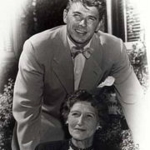
Nelle Clyde Wilson Reagan was born in 1883 and died in 1962.
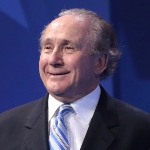
Michael Edward Reagan is an American political commentator, Republican strategist, former radio talk show host, and author.
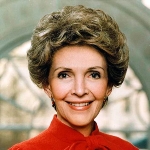
Nancy Davis Reagan was an American film actress and the wife of Ronald Reagan.
Maureen Reagan was born in 1941 and died in 2001.
Patti Davis is an American actress and author.
Ron Reagan is an American former radio host and political analyst for KIRO radio and later, Air America Radio, where he hosted his own daily three-hour show.
Neil Reagan was an American radio station manager.
Jane Wyman was an American actress, singer, dancer, and philanthropist whose career spanned seven decades.
